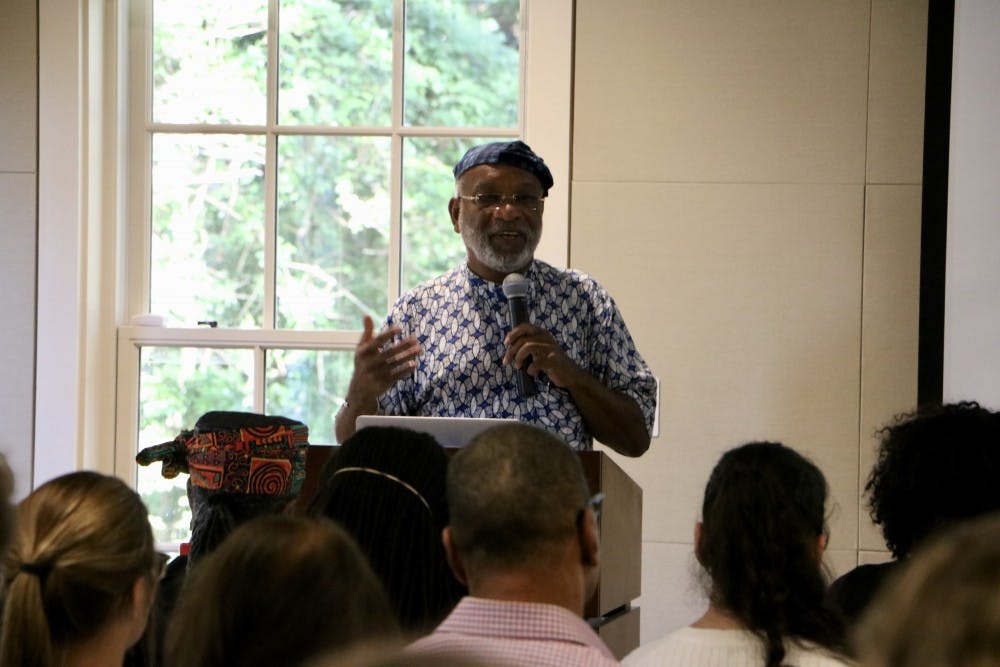Not a seat was vacant in Pebble Hill as supportive fans and curious onlookers waited for the New York Times photographer to speak.
Chester Higgins, photographer for the New York Times, spoke about the behind the scenes of his photographs and how his inspiration for photography was sparked on Oct. 30 at Pebble Hill.
Ecstatic individuals ranging from students to professors anxiously waited their turn to meet Higgins and get his signature in their book of photographs. Behind Higgins, the screen displayed a diverse collection of his work.
“The reason I began as a photographer had to do with seeing myself through my relatives,” Higgins said.
His model interests were his great aunt and uncle who, on their walls, only hung two images.
“I’m going to learn how to take pictures because my great aunt and uncle deserve to have their pictures on the wall,” Higgins said.
The idea of seeing the smiles on their faces when they saw their photographs inspired Higgins to seek out a mentor and learn the art behind the camera.
“I use photographs in a way people use journalism,” Higgins said.
Seeing the depictions of various people in photographs and becoming intrigued to learn the situation behind the image encouraged Higgins to take on the role of a visual storyteller. And with great photography came the necessity for innovative communication and people skills.
“I don’t have a set formula for making photographs because I’m always looking for what the spirit is presenting at that particular time, of that person,” Higgins said.
Inspiring some of his first photographs, Higgins captured the dramatic experience of a child’s first haircut. The tears running down the boy's concerned face is only one example of how the patience of his work captures the emotions of a singular moment.
“As a photographer of people,“ Higgins said. “I’m interested in capturing what’s going on in that split second.”
In order to successfully do this, he said one needed cooperation, but he also emphasized the importance of asking for permission. Through his extensive travels from Africa to Brazil and on to Ethiopia, Higgins discovered that though language might have been a barrier, it was not a reason to admit defeat to a challenge. He learned how to use body language to communicate with his subjects.
Because of his desire to capture various cultures and people while traveling, he sought to make friends with compatible individuals and follow them within their community.
“I wanted to establish a formula where I’m not a photographer who’s coming to take pictures,” Higgins said. “I’m a friend who happens to have a camera.”
And having that camera by his side all the time comes with its benefits and rewards.
“Part of photography is if you see a good picture, you probably missed it,” Higgins said.
Displaying an artistic image to the audience of a flock of birds taking off mid-flight, Higgins looked to prove the importance in always having the camera handy.
“You never know when a good picture will come up,” Higgins said.
However, sometimes being prepared is still not enough to capture the timeliness of an individual, which inspired his recent project of photographing gravestones. Traveling to various cemeteries across the country, Higgins takes photos of past individuals he respects and looks up to.
“I take a picture of their grave because I did not get a chance to photograph them while they were alive,” Higgins said.
A popular project and published book of his, “Elder Grace,” depicted the beauties and relations of the elderly.
“I started taking pictures of older people to show that aging can become a graceful thing,” Higgins said.
The most rewarding result of the project was the response of people finding new models in the elderly, rather than feeling rejected and lost, he said.
After entertaining the audience with a colorful collection and intriguing stories, Higgins left the audience with a simple thought: “I don’t take pictures, I make pictures.”
Do you like this story? The Plainsman doesn't accept money from tuition or student fees, and we don't charge a subscription fee. But you can donate to support The Plainsman.





